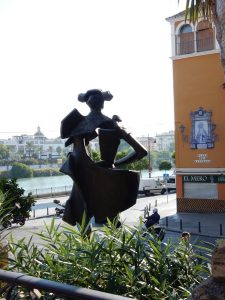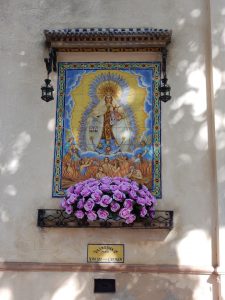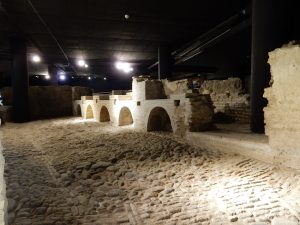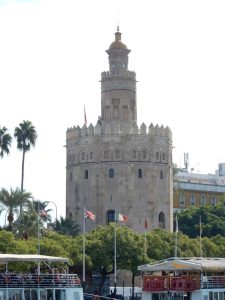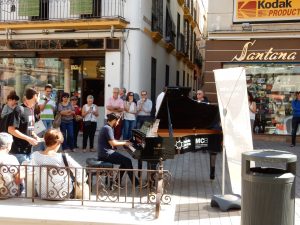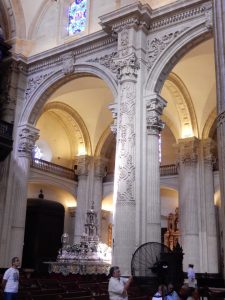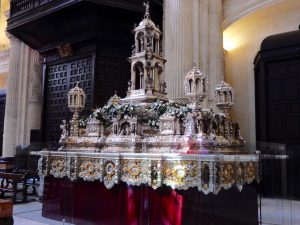September 30, October 1
Wednesday and Thursday were walking days here. We have had very pleasant, just slightly warm days with temperatures in the mid 70s that make for nice walking.
On Wednesday we took a walking tour of some of the Triana district with Marta Casals, a guide we met last year. Before we left we went out for breakfast only to discover that (at least at this time of year) most places that serve desayuno don’t open until 8:30-ish. [That will tell you how late we have been starting if you read between the lines.] We got breakfast while watching little kids, along with their parents or grandparents walk to school. Instead of backpacks, many of the kids have little suitcase-like packs that roll behind them. The school close to where we ate must require uniforms because we saw lots of little students go by in red and white clothes.
We met Marta by our apartment and walked past Plaza Nuevo and down some streets we hadn’t seen before. More places to go back to.
We crossed the Puente de Triana (the Triana Bridge), which is officially known as the Puente de Isabel II bridge. We learned that Triana is an old district–the Romans made tiles there–and tends to see itself as apart from Seville. It was outside the city walls and home to tile makers, gitanos (gipsys), and sailors. I just read that it sometimes calls itself “the independent republic of Triana.” The bridge gives a good view of the district and of the city itself, including the Torre del Oro (Tower of Gold), which was built by the Moors in the early 13th century and extended a bit in the 18th century. It served as a watchtower and defensive position.
As soon as we crossed the bridge into Triana we saw the chapel of the Virgen del Carmen, patron of sailors. Triana is also famous for bullfighters and there is a statue of Juan Belmonte which is oriented so that it points to Seville’s large bullring across the river.
We walked through several small streets. For the most part, they are quieter than the streets in the old district across the river and the houses are smaller and so are the shops.
There are still some tile factories–if by factory you mean low-volume, hand-made, traditional methods–that supply much of the tile for the area. Many of the tiles used in the churches and grand buildings of Seville came from Triana.
While we were walking, Marta pointed out many murals (pictures of scenes made of tiles) on buildings on both sides of the river and she told us that they often are relatively modern, but depict what that particular neighborhood was like 100 years ago. I started to pay more attention then.
After seeing some of Triana’s streets, shops, and corrales de vecinos (common courtyards with small homes around it and usually with a large gate at the entrance), we went to the Mercado near the bridge. There were many, many shops inside with some shops selling fruit, others selling meat or fish, olive oil, pastries, and so on. It was a busy place that looked to be used by a lot of local people. The Mercado is built right next to, and over, the ruins of the Castillo San Jorge (Castle of Saint George) which was the headquarters of the feared Inquisition.
Some of the castle has been excavated below ground level and we went down to see some of the old streets and walls. The whole place is well-signed in Spanish and English and makes the point over and over again how awful the Inquisition was and how such inhumanity should never be allowed to happen again.
After our walk, Marta led us to a small dock on the Guadalquivir where we took a “cruise” up and down the length of Triana on (in?) Captain Pablo’s electric boat. The perspective from this 11-passenger boat of both sides of the river and some of its bridges was very nice. Nice enough, de hecho (in fact) that I forgot to take many pictures. For a while we were the only 4 people on the boat until another small group joined us. There are only a couple of small boats like this that give tours because the big boats don’t want the competition.
In the evening we went out for a meal. There are far too many places from which to choose. We found a place that promised Mexican food and decided to try it. There were plenty of choices on the menu and we had a good meal. It was made more interesting by the fact that our waiter, a young man, had been all the way to Albuquerque where he stayed for 2 days sampling not Mexican (or New Mexican) food, but “American” food–whatever that is.
On Thursday we set out to find the jueves (Thursday) street market on Calle Feria. All we had to do, according to Marta, was go to the square where the “Mushrooms” are located and head out from there.
Las setas (the mushrooms) is a large structure, made of wood often disliked by the locals, made of wood (Norwegian ash + glue) and rising above Encarnacion plaza. The plaza is close to our apartment and we had a nice breakfast there. On setting out for the street market, we found that getting to Calle Feria was going to be more complicated than we (I) anticipated. Despite two maps, Google direction finding, and another set of on-line maps, we never did. Instead, we wandered the narrow streets, getting further and further away–although we did not know it. It didn’t make any difference to our enjoyment of the day, however. We stopped in shops and watched tradespeople work.
We saw a grand piano in a plaza with a person playing it for a benefit and learned that there were pianos in 6 other plazas doing the same thing. We stopped in an old furniture store and Patricia spotted a piece that might work at our house. The proprietor spoke almost no English, but we managed to communicate pretty well. I had to look up how to ask about what kind of wood was used, but other than that Spanish and gestures worked. When I told him that we lived in the U.S., he told me the piece could be shipped by air. We even got a price–not negotiated, because my Spanish won’t go that far.
After wandering over the the river, far, far away from our original goal, we saw the Torre de los Perdigones, a 160-foot tower with a camera obscura on its top and decided that would be our limit. [A camera obscura projects an image of the outside onto a table in a dark room. They are forerunners of cameras.] Perdigones means “shot” and the tower was originally used to create lead shot by dropping molten metal from the top of the tower in to water at its base.
We had a good walk back on now-familiar streets. The El Salvador church was open when we got close to our apartment so I took the opportunity to go inside. It is another church built upon the site of a mosque. It is the second largest church in Seville after the Cathedral. Inside the capillas (chapels) are over-the-top in their design with flourishes and statues which are painted or covered in gold leaf. I am glad I visited.
Writing about El Salvador reminded me that on Wednesday on our tour we were in a church looking at a painting of a sea battle (unusual for a church) a very old man in a formal suit touched Marta on the arm, pointed at the picture and said “batalla de Lepanto” (battle of Lepanto) and walked off. Everybody wants to be a tour guide, she said.

